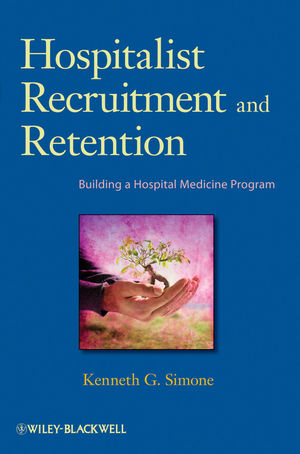Hospitalist Recruitment and Retention: Building a Hospital Medicine ProgramISBN: 978-0-470-46078-8
Paperback
224 pages
December 2009, Wiley-Blackwell
 |
||||||
1 Physician Supply and Demand.
1.1 The Aging Medical Workforce.
1.2 The Growing and Aging Population.
1.3 Decreased Medical School Matriculation.
1.4 The Changing Demographics of Medicine.
1.5 The Cost of Medical School and the Graduate Debt Burden.
1.6 The Changing Role of the Specialist.
1.7 The Changing Scope of Primary Care.
1.8 The Availability and Accessibility of Training Programs.
1.9 Technological Advances.
1.10 The Increasing Regulatory Responsibilities Placed on Physicians.
1.11 Rising Practice Expenses and Diminishing Returns from the Insurance Industry.
1.12 Utilization of Nonphysician Clinicians.
1.13 Government Policy.
1.14 Generational Expectations.
2 The Hospitalist Marketplace.
2.1 Age, Gender, and Years Employed as a Hospitalist.
2.2 Hospitalist Education.
2.3 Hospitalist Practice Location.
2.4 Hospitalist Employment Model and Hospital Teaching Status.
2.5 Control/Hospital Governance of Affiliated Hospital.
2.6 Hospital Size.
2.7 Hospitalist Staffing.
2.8 Coverage Schedule and Night Call Responsibility.
2.9 Hospitalist Program Growth and Turnover.
3 The Role of the Hospitalist.
3.1 Hospitalist Program Patient Type and Encounter Type.
3.2 Hospitalist Time Spent on Nonclinical Activities.
3.3 Leader Time Spent on Administrative Activities.
3.4 Hospitalist Activities Based on Location.
4 The Hospitalist Recruitment Pool.
4.1 Building Your Recruitment Network.
4.2 Identifying Your Candidate Pool.
5 Challenges Recruiting Hospitalists.
5.1 Physician Compensation.
5.2 Practice Model.
5.3 Work and Call Schedule.
5.4 Daily Workload.
5.5 Added-Value Benefits.
5.6 Medical Staff Support.
5.7 Hospital Culture and Systems.
5.8 Technology.
5.9 Specialty Providers.
5.10 Referral Network.
5.11 Hospital Administrative Support.
5.12 Staff Stability.
5.13 Community and Practice Culture.
6 Incentive Plans.
6.1 Incentive Plan Objectives.
6.2 Data Systems.
6.3 Metrics.
6.4 Benchmarking.
6.5 Incentive Payout.
7 National Recruitment Initiatives.
7.1 Trend in Hospitalist Salary.
7.2 Type of Incentives Offered for All Specialties.
7.3 Relocation Pay, and Amount, for All Specialties.
7.4 Signing Bonus, and Amount, for All Specialties.
7.5 Amount of CME for All Specialties.
7.6 Additional Benefits.
7.7 Hospital-Employed Job Opportunities.
7.8 Assessment of Fair Market Value and Physician Compensation.
8 Retention Initiatives.
8.1 Defining Expectations and Finding the Appropriate Fit.
8.2 Work–Life Balance.
8.3 Integration of the Hospitalist Program and Hospitalist Physicians.
8.4 Support from the Clinical Director and Sponsoring Hospital.
8.5 Clinical and Operational Support.
8.6 Opportunities for Career Growth and Advancement.
8.7 Financial Opportunities.
8.8 Spousal/Significant Other and Family Integration Within the Community.
8.9 The Orientation Program.
8.10 The Exit Interview.
9 Putting It All Together: The Site Visit and Interview.
9.1 The Contact.
9.2 The Site Visit.
9.3 The Recruitment Team.
9.4 Discussion Topics.
9.5 The Interview.
9.6 The Postvisit Phase.
9.7 Hiring Protocol.
10 The Contract.
10.1 Employment Arrangement.
10.2 Qualifications.
10.3 Standards of Service.
10.4 Physician Services.
10.5 Duties and Responsibilities of the Employer.
10.6 The Term of Employment.
10.7 Hours of Employment.
10.8 Compensation.
10.9 Professional Liability.
10.10 Employment Activities Outside the Practice.
10.11 Restrictive Covenants.
10.12 Termination of Employment.
10.13 Patient Record Ownership.
10.14 Confidentiality.
10.15 Financial Relationship Between Employer and Physician.
11 Practice Management Strategies.
11.1 The Hospitalist Budget.
11.2 Hospitalist Staffing.
11.3 Program Policies and Procedures.
11.4 Practice Support.
11.5 Strategic Planning.
11.6 Collaborative Systems of Care.
11.7 Marketing the Program.
12 Targeting Program Leadership.
12.1 Attributes of Effective Program Leadership.
12.2 Mentoring Potential Leaders.
12.3 Leadership Versus Management.
12.4 Identifying and Recruiting an Effective Leader.
12.5 Practice Culture and Career Satisfaction.
13 Concluding Thoughts.
References.
Index.



